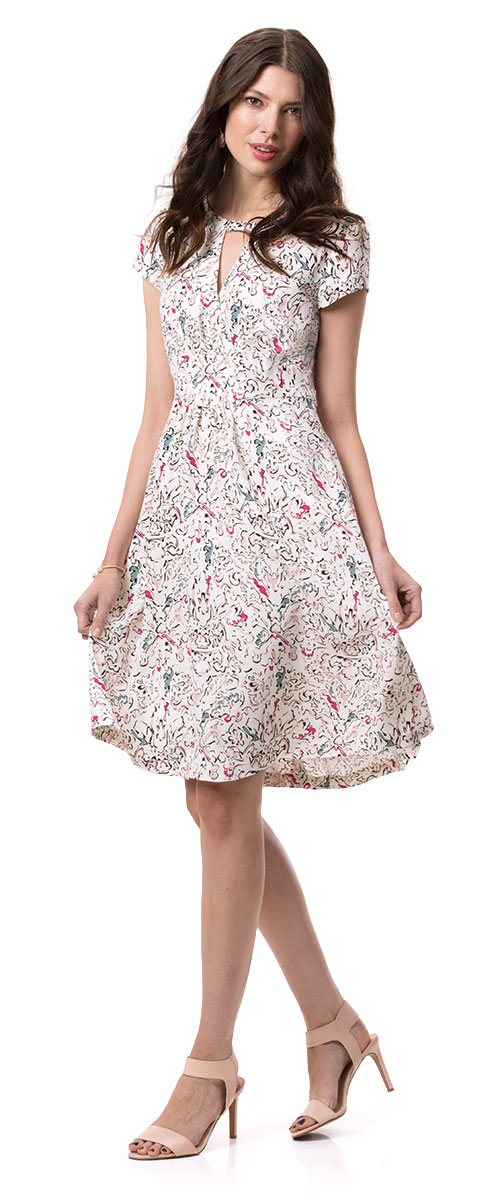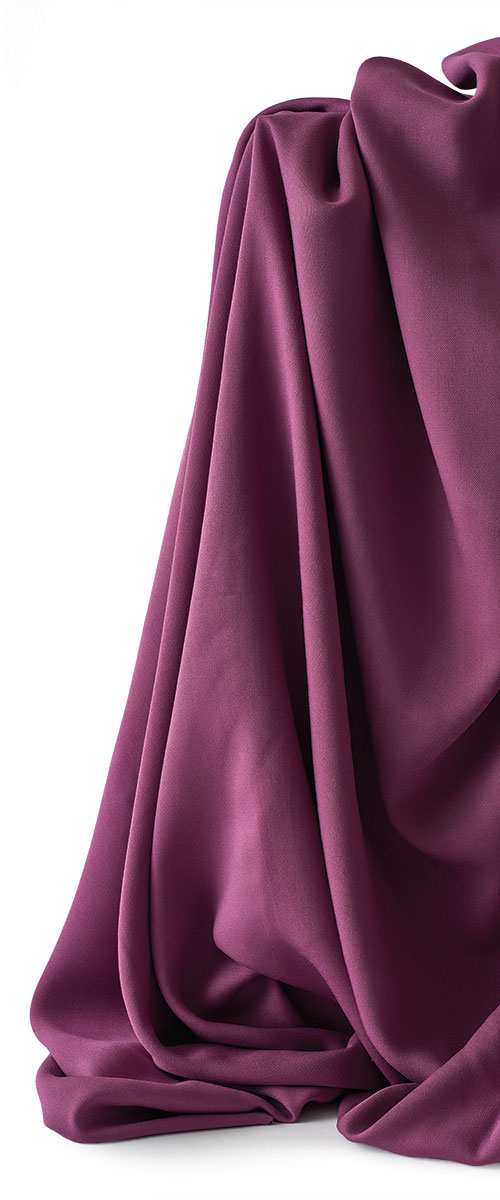
Rayon is a fabric made of regenerated cellulose from plant sources including wood pulp. While this fiber comes from natural sources, it is made with chemical processes, which puts it between the natural and synthetic worlds. There is some debate about the environmental impact of rayon fabrics. Other manufactured cellulose fibers, such as Tencel (lyocell) and modal, are considered more environmentally responsible.
Rayon is cool to wear and takes dye well. Today’s rayons retain their shape, shrink and wrinkle less, and drape better than their predecessors. There are several types of rayon fabrics, each with its own qualities. Cuprammonium rayon, made in Switzerland and Germany, is more refined and has more weight than some rayons made in the United States; it feels more like three-ply silk.
Rayon is suitable for wide-leg pants, full or A-line skirts, and boxy shirts. Avoid close-fitting styles and choose silhouettes with flowing lines.

Preparation and cutting
Preparing rayon fabric is simple but essential for smooth sewing.
Preshrink the yardage. Machine-wash it alone in cold water with Ivory liquid detergent on the gentle cycle. Wet fabric distorts with too much agitation. Machine-dry the yardage on the permanent press cycle. Remove the fabric from the dryer while it is slightly damp and iron it dry.
Press with caution. A dry iron on medium temperature works best because moisture stretches the fabric. Since some dye may transfer during pressing, use a disposable press cloth such as a paper towel. Some rayons need to cool on the pressing surface before being moved, or wrinkles will develop. Overpressing can cause fabric shine. Rub the shiny area against self-fabric to restore the surface.
Choose a cutting layout. Use a without-nap layout, double thickness. For cutting accuracy, tape tissue paper to the worksurface. Pin the double-fabric thickness to the tissue at 12-inch intervals. Pin the pattern through the fabric and tissue layers.
Cut with sharp tools. Use scissors or a rotary cutter to cut through all layers, including the tissue.
Appropriate notions
Rayon fabrics are typically lightweight and somewhat unstable. These tools ensure smooth and accurate stitching.
Marking tools: A Pilot FriXion erasable ink pen, Clover Chaco Liner, or tracing paper and a wheel are recommended. Test the marking tool on your fabric to ensure that marks come off cleanly.
Interfacing: Fusibles adhere well but can come loose after laundering. Silk organza works well as interfacing when fusibles do not adhere.
Thread: Use cotton thread only. A seam sewn with polyester thread can shred under stress.
Needle: Install a new 70/10 jeans needle or 70/10 microtex, or sharp, needle. A dull needle can create fabric snags. Presser foot: A standard all-purpose or zigzag presser foot works well.

Technique advice
Choose methods that help control rayon’s tendency to become distorted.
Pin accurately. Despite your best efforts at accurate cutting, seam lengths can differ when you pin two or more layers together. Pin with the shorter fabric piece on top, matching the top and bottom of both pieces. Let the sewing machine’s feed dogs ease in the longer side to match the shorter one.
Select a stitch. For long side seams, sew with a narrow zigzag, 0.5 mm wide and 2.5 mm long. This enables seams to relax as the fabric relaxes.
Finish seams neatly. Sew flat-felled seams or press seam allowances open, and then serge the allowances separately with fine serger thread.
Edgestitch for emphasis. Achieve beautiful results by stitching 1/8 inch from the finished edge using a topstitching foot.
Sew the hem. Serge the raw edge, turn up 1 inch, and hand-hem. For unstable rayons, press Lite Steam-A-Seam 2 in a 1/2-inch hem allowance to prevent stretching. Turn and then topstitch with a twin needle.
Sandra Betzina is the author of All New Fabric Savvy (The Taunton Press, 2017), from which this article is adapted.
































Many thanks for this very helpful article. I’ve avoided this fabric type after a disastrous attempt to make a simple flowy top — I am ready to try again!
You mentioned tencel and modal fabrics - do the same concepts apply?
Thank you
Maura
Yes, the same concepts to apply for Tencel and modal. Every fabric has different characteristics, but these manufactured cellulose types can be similar and have many of the same handling requirements.
Carol J. Fresia, Threads Senior Technical Editor
I'm working on a bias cut skirt out of a lightweight rayon challis. The fabric is warping or waving at the seams and I don't know why or how to fix. Can you help?
That's a common problem with these fabrics, as they are drapey and rather unstable. One way to prevent or at least mitigate rippling in bias seams is to sew them as you might a stretch knit: with a narrow zigzag stitch. Try 1.0 mm to 1.5 mm wide, with a length of about 2.5 mm. This looks almost like a straight stitch, but it has a bit more give. Sew the seam and press it, stretching it gently as you press. Let the garment hang for at least 24 hours before marking and sewing the hem. Depending on your particular fabric, it's possible that the fabric will continue to stretch over time, and you may have to revisit the hemline once in a while. Ask me how I know!
Carol J. Fresia, Threads Senior Technical Editor